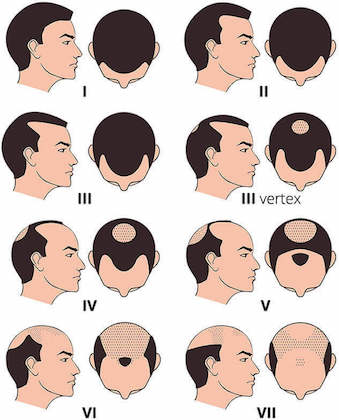The Norwood Scale – What it Means for Balding
The appearance of balding areas on the scalp is a common problem for many men around the world. Hair loss can impact the self-image of a person as well as cause them to try and find methods that help them gain the hairline they desire. The amount of balding on the scalp is generally determined by a scale of measurement that is known as the “Norwood Scale”. Here is a closer look at what each portion of the Norwood Scale signifies in terms of the amount of hair loss that a person is experiencing.
The Norwood Scale Explained
The different parts of the Norwood Scale help a doctor to determine the amount and severity of hair loss on the scalp of a patient. In general, the Norwood Scale spotlights seven different stages of hair loss patterns in patients.
These seven stages are:
 Stage One – The person does not have any visible or obvious signs of hair loss on the scalp. The person will still be enjoying a full head of hair but there might also be some mild thinning on the scalp.
Stage One – The person does not have any visible or obvious signs of hair loss on the scalp. The person will still be enjoying a full head of hair but there might also be some mild thinning on the scalp.- Stage Two – The hair can be falling out at the hairline which is often regarded as the first signs of receding hair around the temples.
- Stage Three – This stage is the one where the hair loss of a person starts to become noticeable to others. The hairline is starting to recede from the temples of the person. In addition, the areas where the hair has recessed might be completely bald or have a thin covering of hair. Plus, the person will have an “M-shaped hairline”.
- Stage Four – A person will start to see a more severe amount of hair loss at the crown of the head as well as the hairline.
- Stage Five – The hair loss will continue at both the crown and the hairline of the person. The two areas on the scalp are usually separated by a narrow and thin strip of hair.
- Stage Six – The person is mostly bald on the top of their head.
- Stage Seven – The hair loss also impacts the sides of the scalp as well. At this point, the person will likely only have a thin ring of hair going around the head.
What the Norwood Scale Means in Terms of a Hair Transplant
If a person has hair loss that falls in the first two stages of the Norwood Scale, that person will likely not need to undergo a hair transplant procedure. Many people start to think about having hair restoration surgery when they are classified as being in the 3rd or 4th stages of the hair loss shown on the Norwood Scale.
If the person wants to wait until the final few stages of the Norwood Scale to think about having a hair transplant (stages six and seven), hair restoration surgery might not be a viable option because the hair that is remaining on the scalp is often quite thin by that point.
In general, it is best to explore any hair transplant options in stages three and four (and maybe even stage five) of the Norwood Scale. Patients that are not sure which stage they are in can schedule a consultation appointment with a doctor experienced in performing hair restoration.
Hair Transplant Options for Men in Later Norwood Stages
Patients that are in the sixth and seventh stages of the Norwood Scale might still be able to have a hair transplant depending on the amount of hair that is available elsewhere on the body. Donor hair for the scalp can come from areas such as the beard or the chest or other sections of the body that have a good amount of donor hair.
If a patient has some high-quality hair left on the donor area of the scalp (the sides and back of the scalp), then that hair can be used by an experienced and qualified hair transplant surgeon as donor hair for a hair transplant procedure.
No matter the level of their hair loss on the Norwood Scale, patients that are interested in having a hair transplant should schedule a consultation appointment with a board-certified surgeon. The surgeon can examine the scalp of the patient to determine the exact amount of hair loss as well as the reasons for the loss of hair on the scalp. Once the reason for the hair loss has been determined, the surgeon can make a plan to restore as much hair as possible on the scalp.
One of the most important parts of making a hair transplant plan is setting realistic expectations for the type of results the patient can expect to see. Once the doctor and the patient agree on the hair transplant technique and results, the actual hair restoration procedure can be scheduled.
MA